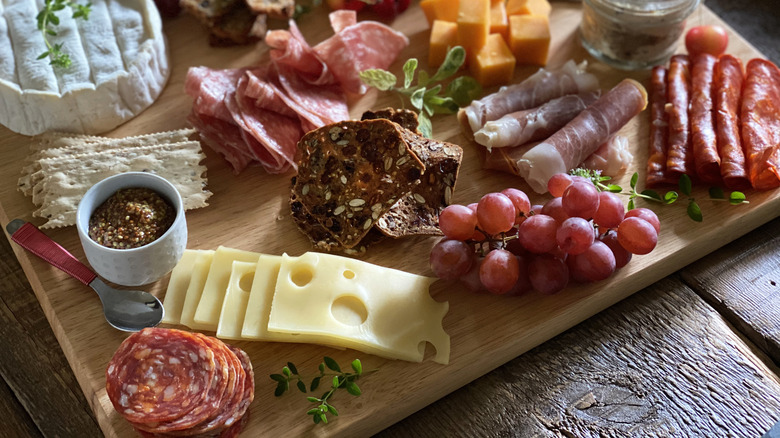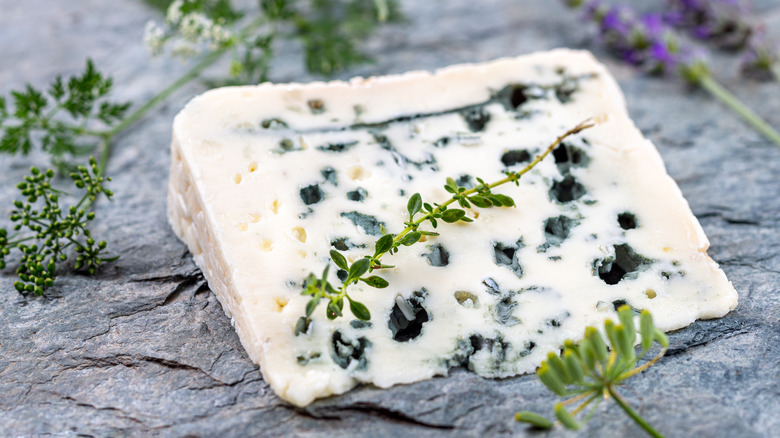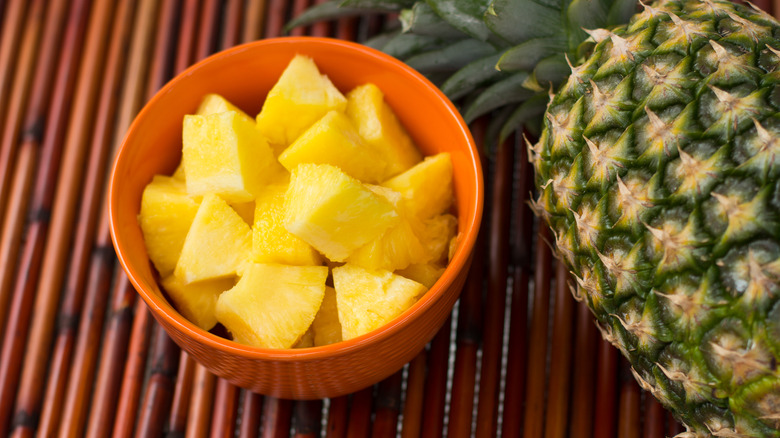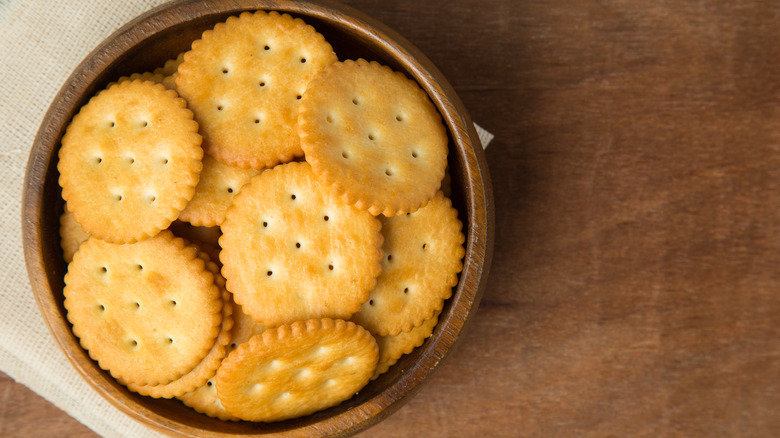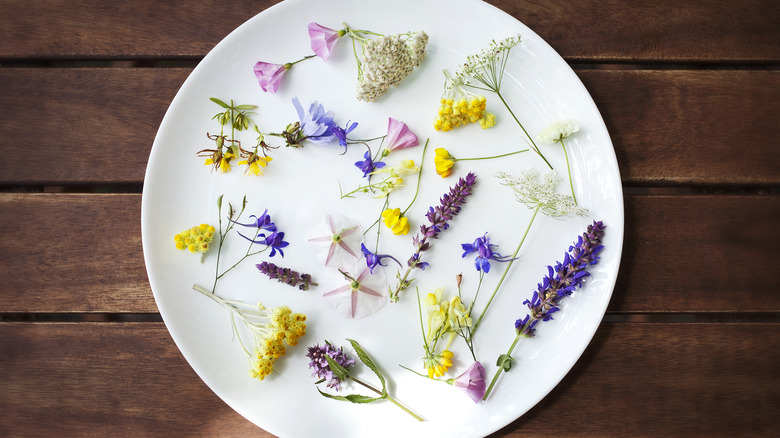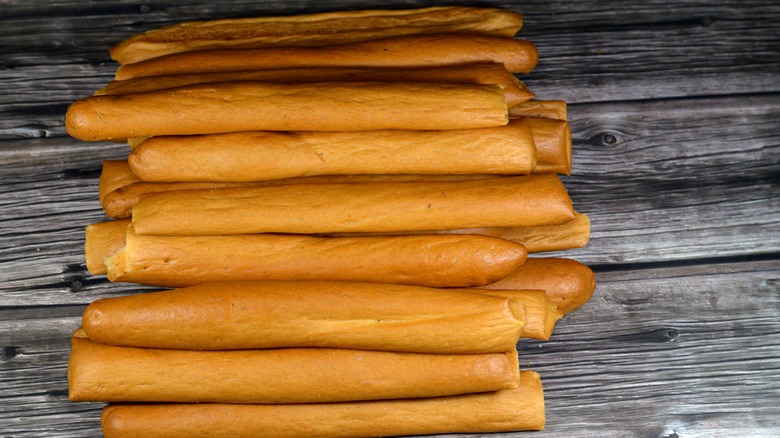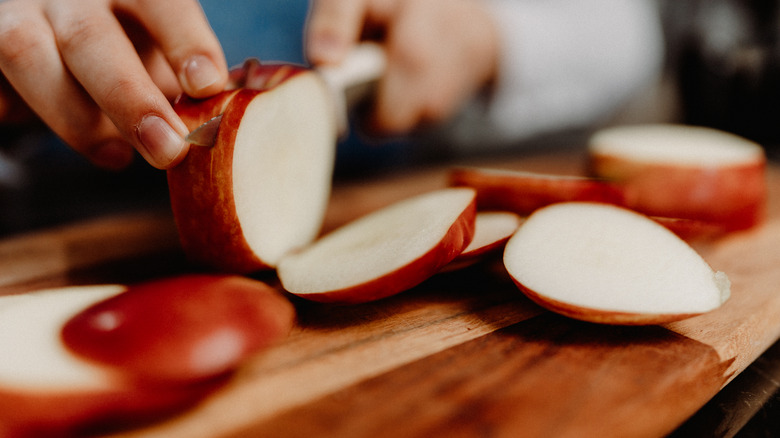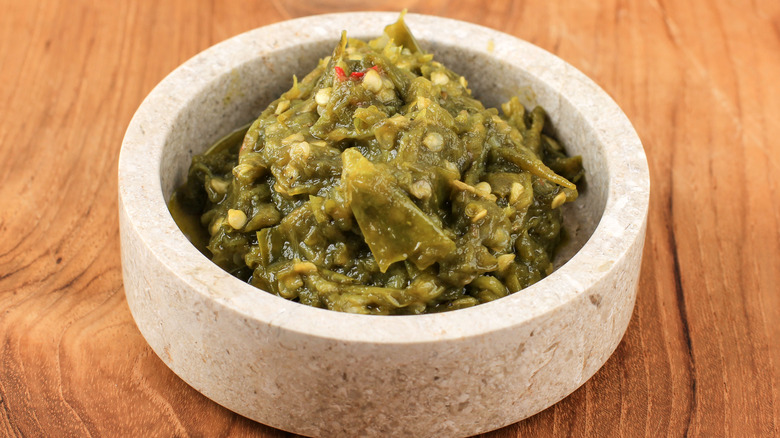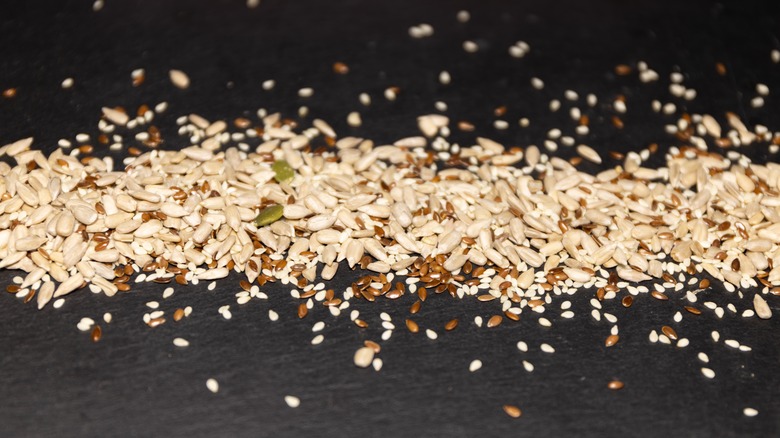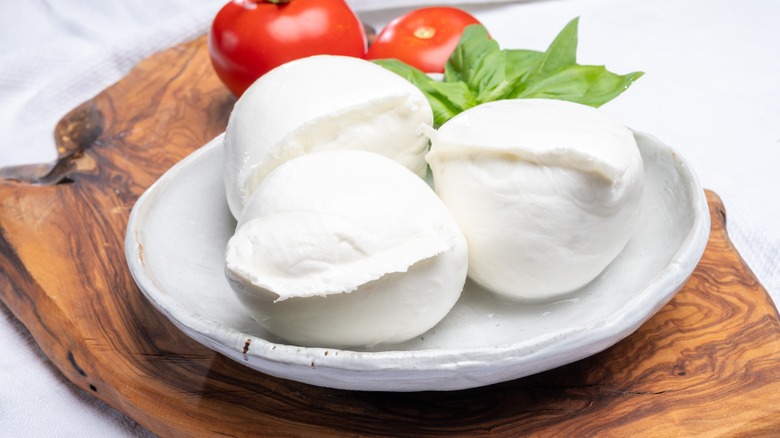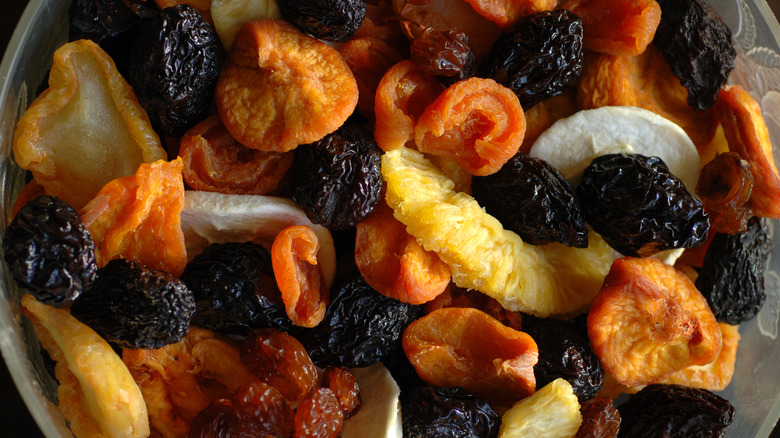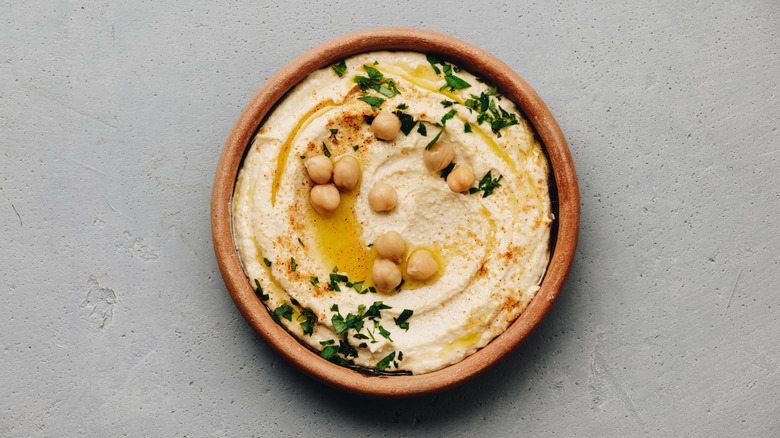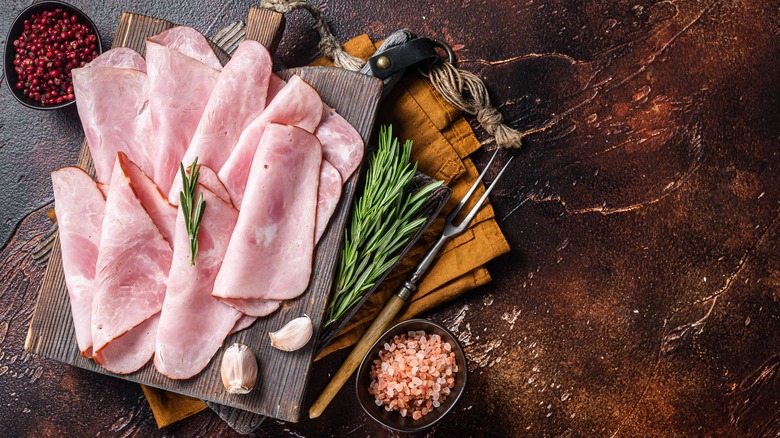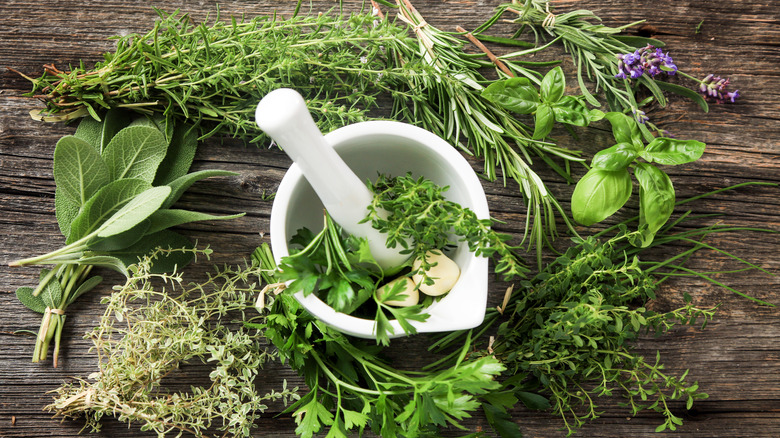13 Ingredients That Are Ruining Your Charcuterie Board
Putting together a charcuterie board is an art. When done well, this classy method of serving food can be a crowd-pleaser that caters to everyone's individual tastes yet remains in keeping with your overarching theme. Unfortunately, though, there are a lot of common mistakes that plague charcuterie boards, and one of them is including the wrong ingredients.
In their purest form, charcuterie boards are fairly traditional and are primarily a method of serving sliced cured meats. These days, most people include cheeses, sliced fruits or vegetables, and items like crackers or nuts on their boards. However, some folks take things way too far and consider their charcuterie boards to be a method of serving pretty much anything they want. This can create terrible flavor clashes, weird textural inconsistencies, and an unpleasant meal for everyone.
Interestingly, too, this can happen with some of the most common ingredients that people add to charcuterie boards, with certain types of cheeses, fruits, and even meats being commonly found on the boards but inadvertently ruining them. Other ingredients can be used more decoratively but clutter your board and produce strange tastes you really don't want. If you're sick of ruining your charcuterie boards, you'll want to avoid these items.
1. Particularly stinky cheeses
Cheese is a food that caters for many different tastes, and for some people, the more pungent a cheese is, the more they love it. However, when it comes to your charcuterie boards, you should leave the stinky cheeses off them. Placing particularly stinky cheeses on your charcuterie board immediately makes them the dominant item, distracting from all of the other ingredients in front of you. The cheese's scent will also persist while you're trying to eat the items you've picked, pervading every bite of food you're taking.
Placing a stinky cheese on your charcuterie board can also nudge it up against the other items, leaving cheese residue on them and making them taste off. Additionally, the scents of these cheeses are especially prone to soaking into more porous woods, and once the smell has settled in, you'll have trouble shifting it. Instead, narrow your selections on your cheeseboard and go for a few choice options that you know will appeal to everyone. You'll want a maximum of four cheeses on your board — we'd recommend going for two mild and two medium options. If you know you have guests who love stronger cheeses, consider serving it to them separately, so it doesn't affect your charcuterie board.
2. Pineapple
Now, don't get us wrong here: We love pineapple, and we think it goes well in plenty of foods. We just don't think it's great on charcuterie boards. The problem with pineapple, as well as other tropical fruits like mango, is that when it's at room temperature, it tends to sweat and release its juice. If it's sitting in a bowl on its own, this isn't really an issue — but when it's sitting with other food items on a flat board, you'll quickly find that everything becomes coated in pineapple juice. Plus, that same pineapple juice can then start to drip off the side of the board, creating a cleanup operation you could probably do without.
Rather than make more work for yourself, emphasize different fruit options on your board and go for items that will stay dry yet delicious. Grapes, cherries, and berries are all good options, as their skins keep their juices contained, and they're super flavorful at room temperature. Sliced figs and apricots are also great choices, giving your charcuterie board some squishy textures that go well with cheese. Peeling tangerines and placing individual segments on the board can give it a pop of bright citrus flavors.
3. Ritz crackers
Ritz crackers are one of the most popular accompaniments to cheese. We can see why that's the case: These bite-size morsels are affordable and widely available and bring a buttery, salty pop to each mouthful. However, we're not convinced that they're the best choice on a charcuterie board. In our opinion, Ritz crackers are just too sweet and, dare we day, artificial-tasting for this classy serving method. The whole point of a charcuterie board is to be able to enjoy small morsels of quality artisanal foods — so why would you ruin things by bringing these crackers along for the ride?
The best accompaniments for your cheese are milder-flavored crackers, ideally those that have a more interesting texture. High-quality multigrain crackers are a good option, as they can bring a grainy, slightly rough consistency that contrasts your cheese well, and a nutty flavor that isn't too salty or doughy. Alternatively, go simple by adding some water crackers to your board. Water crackers allow the flavors of your cheeses and meats to stand out, providing you with a subtle base to build intense tastes on.
4. Edible flowers
We're calling time on edible flowers for charcuterie boards, people. Edible flowers may be a gorgeous way to elevate your salad, but on charcuterie boards, they just get in the way of your food. The whole point of a charcuterie board is that when you put it on the table, your guests should be blown away by the abundance of food on offer, and the impressive range of delectable morsels. Putting edible flowers on top of everything not only hides said morsels, but it kinda gives the impression that you're trying to make it look more exciting than it actually is.
As edible flowers often come from plants like lavender, arugula, and thyme, they can have a distinctive flavor. While this may be nice in certain situations, on charcuterie boards, these flavors can get in the way of your actual food. Additionally, edible flowers can take up precious space for the food you really want to include. Instead, focus on offering a wide selection of different items which will offer a visual impact with the promise of everything being tasty. Save the edible flowers for your other dishes — you don't need them here.
5. Breadsticks
With the sharp-tasting meats, cheeses, and fruits that make up your charcuterie board, it's easy to assume that you need a neutral-tasting element to contrast them. Enter breadsticks, a common feature on charcuterie boards, and beloved by many for their crunchy yet soft texture, as well as their versatility. While there's a time and a place for breadsticks, though, it's not here. Breadsticks are just way too big and unwieldy to be placed on a charcuterie board, and they take up valuable real estate that could be better utilized with more flavorful elements.
The shape of breadsticks is also an issue. Unlike crackers, which are small, compact, and flat, lending themselves to toppings, breadsticks are round and long, making placing them on anything a challenge. These food items are better paired with dipping sauces usually intended for pizza crusts – but if you start cluttering your charcuterie board with dips, you'll barely have any space left for the meat and cheese. Save yourself the annoyance of your breadsticks rolling off your charcuterie board as you transfer it to the table and go for a few well-placed piles of crackers instead.
6. Apples
Apples make a lot of sense on a charcuterie board. These tart, crunchy fruits are a natural accompaniment to cheese, with their sour sweetness offsetting the creaminess of dairy perfectly. Unfortunately, though, your apples may well look worse for wear by the time they get to the table. Like many fruits, apples' interiors begin to oxidize when they come into contact with air, and this oxidation is what gives them that murky brown color.
Air-exposed brown apples are perfectly edible, so using them doesn't necessarily pose a health risk. The reason you should avoid them, however, is because they'll ruin the appearance of your charcuterie board. If you do want to use apples, it's best to slice and place them on your board just before serving it. You can also use certain tricks, like the tried and tested rubber band hack, to keep the flesh fresh for longer. Otherwise, it's probably best to use fruits that won't oxidize, or which come in small portions with their skins still intact. Be sure to steer clear of other fruits that will oxidize when sliced, like bananas or pears.
7. Spicy jams or relishes
Jams and relishes are a delightful addition to charcuterie boards. Tart, sweet, and salty, these condiments can contrast cheese beautifully and go well with many different deli meats. They also add a useful burst of moisture, helping to stop your various components from being too dry.
You need to keep an eye on spice levels, though. Spicy jams and relishes might seem like a good way to make things more exciting, but they can often be distracting at best, taking the focus away from the flavors of your main ingredients, and actively painful at worst. There are loads of different types of peppers that can be used to make these jams and relishes, and some of them are astonishingly fiery. Unless you've done a taste test and you're certain that all of your guests can handle the heat, you may end up ruining someone's meal inadvertently. Instead, we would always recommend going for mild-tasting jams, relishes, and chutneys, to play it safe. If you know that you have a few guests who like spice, consider serving a few hotter options on the side.
8. Seeds
Seeds often show up on charcuterie boards, and they always leave us a little bit underwhelmed. We can understand the logic here: Seeds provide a scattering of color over your items, making everything look more appealing. Their smaller size can also provide a nice contrast from the chunkier slices and shapes on your board, and additionally, they give some much-needed crunchy textures to the dining experience.
That small size, though, also creates some issues. Charcuterie boards are all about picking things up and popping them in your mouth, but when you're trying to scrabble around to pick up seeds, you can end up poking, prodding, and smearing everything else on the board. Plus, their smallness means that they can end up everywhere, instead of being contained in one place, and end up in every bite of your food — which can just get annoying. It's also worth remembering that seeds, like nuts, can be uniquely triggering to allergies, and uniquely dangerous, potentially producing symptoms like facial swelling, stomach pain, and more severe anaphylactic reactions. While you might be okay if none of your guests have a seed allergy, if there's any doubt whatsoever, they should be avoided entirely.
9. Mozzarella
Charcuterie boards give us all an excuse to chow down on our favorite cheeses (as if we needed an excuse to do that). Some cheeses, however, are best left off the board entirely. This is the case with mozzarella, which may be the perfect cheese for pizza, pasta, and Caprese salads, but just gets in the way here. Mozzarella's mildness means that it doesn't contribute much flavor-wise in a charcuterie board setting, where punchy, bold flavors dominate. This same mildness also means that it doesn't gel especially well with chutneys or crackers, which require sharp and funky (but not too stinky) cheeses for the right contrast.
This cheese's softness can also be slightly problematic. When it's room temperature, mozzarella can get floppy, gooey, and, dare we say, a little sweaty. The last thing you want is mozzarella smears all over your other ingredients, not to mention its juices giving all of your food an annoyingly creamy flavor. If you are craving a mozzarella-like cheese, try scamorza instead. This cow's milk cheese has a similar texture to mozzarella but tends to be slightly firmer, making it hold up better on charcuterie boards. It also has a sharper, more concentrated flavor, and its smoked varieties can bring a woody, charred intensity to your dish.
10. Dried fruit
We can see the thought process behind using dried fruit on a charcuterie board. These squidgy, sweet morsels of food provide you with all the flavor of fruit, without any of the annoying prep work. They're also reliably tasty, don't suffer from oxidation, and don't leave you with any unnecessary moisture to contend with.
However, their very sweetness can also be a real issue. While fresh fruit gives you a pop of tart, bright-tasting flavor, dried fruit's concentration means that it's super-high in sugar, making it taste similar to candy. Now, that might be well and good when eating it as a snack, but charcuterie boards are all about balance. Including it on your board can overwhelm pretty much everything else. Dried fruit's texture also doesn't go super well with meat or cheese, which benefit from the crisp juiciness of fresh fruit.
That's not to say that dried fruit is completely off-limits, though. If your charcuterie board is more focused on sweet flavors, or you're making a dessert charcuterie board (yep, they're a thing!), it can make an interesting addition. Generally, though, you should stick to fresh fruit.
11. Hummus
Hummus isn't a feature of classic charcuterie boards, but as time goes on, it appears more and more. Its creamy, chunky texture and savory flavor makes it a particular favorite as a plant-based option, and it goes excellently with crackers and crudités. However, we're of the opinion that it's actually a bit of a distraction on charcuterie boards.
When you think about what hummus actually is, this starts to make sense. Its blend of oil and tahini makes it incredibly rich and creamy, but this richness can leave a strong taste on your tongue, getting in the way of your next bite of food. Additionally, hummus can be a bit messy, and if you're not careful, you'll end up with flecks of it all over the rest of your items.
There's nothing wrong with including a few dips on your charcuterie board, though. We would just recommend opting for something a bit punchier and less heavy. Tangy red pepper dip or fresh, bright tzatziki can give you that dippable consistency without lingering on your tongue for so long. A simple mixture of balsamic vinegar and olive oil can also give you some much-needed moisture, while balancing the fat with some sharp acidity.
12. Supermarket sliced ham
In the pursuit of a variety of sliced meats for your charcuterie board, it can be tempting to go for something simple and well-known. This is where supermarket sliced ham comes into the picture. Reliable, cheap, and available everywhere, it's something that most people enjoy, so why not go for it?
Because there are so many better options, that's why. A charcuterie board is all about elegance, luxury, and offering your guests some well-chosen morsels of quality food. Supermarket ham is, more often than not, industrially produced, and when it's served on its own, it can feel cheap and taste overly salty and lacking in nuance. This is all the more obvious when you place it next to artisanally made meats, where you can taste the quality and love poured into every slice.
Rather than use supermarket sliced ham, we recommend seeking out the best types of meat for your charcuterie board. Classics like prosciutto and jamón ibérico are always firm favorites, with both of them offering deep complexity and a punchy, salty flavor. Bresaola is also a great alternative: Made with beef instead of pork, it has a deeper, slightly spicier taste.
13. Fresh herbs
Fresh herbs are one of our favorite garnishes, and somewhere along the line, people started garnishing their charcuterie boards with them, too. We'd really love it if they'd stop doing that, though. Fresh herbs may make your charcuterie board look bright and verdant, but they can also be incredibly pungent, both flavor-wise and on a scent level. This pungency can then seep into any item they come into contact with, making everything on your charcuterie board taste of rosemary or thyme.
If you bite into a sprig of one of these fresh herbs, they deliver a concentrated flavor, overriding any other taste that crosses your palate for several bites afterward. Plus, we're not altogether convinced that the fresh, peppery tastes of parsley or cilantro go that well with creamy cheese and briny cured meat. Rather than add color using herbs, go for an assortment of freshly cut vegetables. Veggies like cucumber, celery, and snow peas can provide a burst of greenness, and be paired with any dips or chutneys you have on your board, without delivering an overwhelming flavor.
